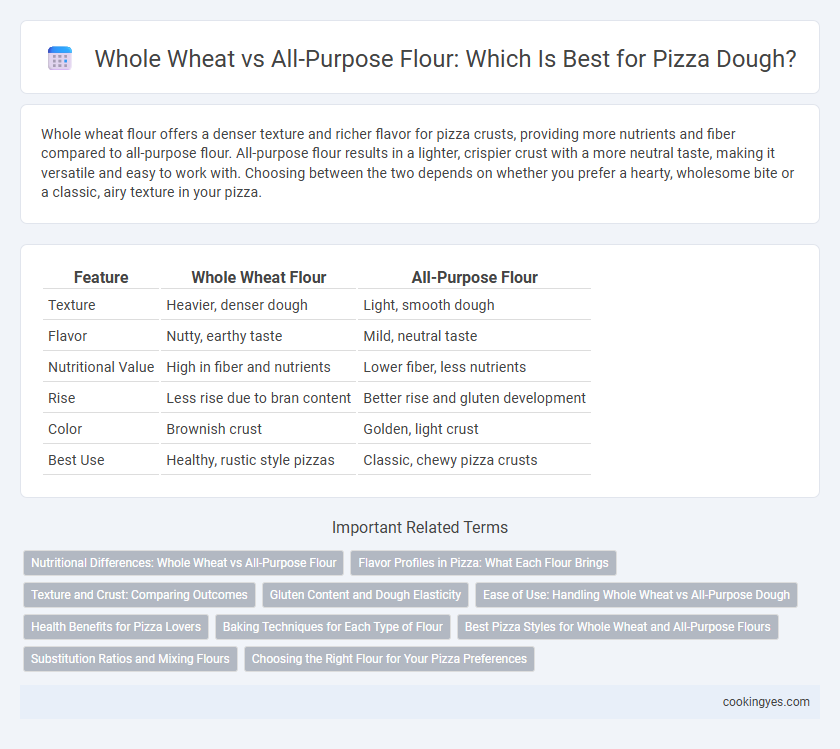Whole wheat flour offers a denser texture and richer flavor for pizza crusts, providing more nutrients and fiber compared to all-purpose flour. All-purpose flour results in a lighter, crispier crust with a more neutral taste, making it versatile and easy to work with. Choosing between the two depends on whether you prefer a hearty, wholesome bite or a classic, airy texture in your pizza.
Table of Comparison
| Feature | Whole Wheat Flour | All-Purpose Flour |
|---|---|---|
| Texture | Heavier, denser dough | Light, smooth dough |
| Flavor | Nutty, earthy taste | Mild, neutral taste |
| Nutritional Value | High in fiber and nutrients | Lower fiber, less nutrients |
| Rise | Less rise due to bran content | Better rise and gluten development |
| Color | Brownish crust | Golden, light crust |
| Best Use | Healthy, rustic style pizzas | Classic, chewy pizza crusts |
Nutritional Differences: Whole Wheat vs All-Purpose Flour
Whole wheat flour contains higher fiber content, essential vitamins, and minerals compared to all-purpose flour, which is more refined and lower in nutrients. The increased fiber in whole wheat flour aids digestion and provides a slower release of carbohydrates, promoting better blood sugar control. In contrast, all-purpose flour offers a lighter texture but lacks the nutritional benefits found in whole wheat, making whole wheat a healthier choice for nutrient-dense pizza dough.
Flavor Profiles in Pizza: What Each Flour Brings
Whole wheat flour imparts a nutty, earthy flavor and denser texture to pizza crusts, enhancing the overall complexity and providing a heartier bite. All-purpose flour produces a lighter, milder taste with a chewier texture, allowing toppings and sauce flavors to dominate. Choosing between whole wheat and all-purpose flour depends on desired crust characteristics and flavor balance in the pizza.
Texture and Crust: Comparing Outcomes
Whole wheat flour produces a denser, chewier pizza crust with a robust, nutty flavor due to its higher fiber content and bran particles, resulting in a heartier texture. All-purpose flour creates a lighter, softer crust with a crispier edge, thanks to its moderate gluten level and refined texture, making it ideal for traditional Neapolitan or New York-style pizzas. Choosing between whole wheat and all-purpose flour impacts the crust's elasticity, chewiness, and overall bite, influencing the pizza's taste and mouthfeel.
Gluten Content and Dough Elasticity
Whole wheat flour contains higher fiber but lower gluten content compared to all-purpose flour, which affects the dough's elasticity by producing a denser, less stretchy crust. All-purpose flour, with moderate gluten levels around 10-12%, offers balanced elasticity and chewiness ideal for traditional pizza dough. Choosing all-purpose flour results in a softer, more pliable dough, while whole wheat flour creates a heartier texture with reduced rise and elasticity.
Ease of Use: Handling Whole Wheat vs All-Purpose Dough
Whole wheat flour dough tends to be denser and less elastic than all-purpose flour dough, making it slightly more challenging to stretch and shape. All-purpose flour creates a smoother, more pliable dough that is easier for both beginners and experienced bakers to handle. The higher gluten content in all-purpose flour contributes to better dough elasticity, enhancing ease of use during pizza preparation.
Health Benefits for Pizza Lovers
Whole wheat flour offers higher fiber content, essential vitamins, and minerals compared to all-purpose flour, promoting better digestion and sustained energy levels for pizza lovers. The increased bran and germ in whole wheat flour contribute to improved heart health and blood sugar regulation, making it a healthier alternative. While all-purpose flour creates a softer crust, whole wheat flour provides a nutrient-rich dough with a slightly denser texture that supports overall wellness.
Baking Techniques for Each Type of Flour
Whole wheat flour absorbs more water and requires longer kneading to develop gluten, resulting in a denser, chewier pizza crust, while all-purpose flour produces a lighter, crispier texture due to its moderate protein content. When using whole wheat flour, it's essential to allow for extended fermentation times to improve dough elasticity and flavor complexity. All-purpose flour dough benefits from shorter rising periods and higher baking temperatures for a crisp, golden crust.
Best Pizza Styles for Whole Wheat and All-Purpose Flours
Whole wheat flour, rich in fiber and nutrients, is ideal for rustic, hearty pizza styles like Sicilian and whole grain crusts, offering a denser texture and nutty flavor. All-purpose flour, with its moderate protein content, provides a balanced gluten development perfect for classic Neapolitan or New York-style pizzas, resulting in a crispy yet chewy crust. Choosing between these flours depends on desired crust texture and flavor profile, with whole wheat enhancing robustness and all-purpose ensuring lightness and flexibility.
Substitution Ratios and Mixing Flours
Whole wheat flour can be substituted for all-purpose flour in pizza dough at a ratio of about 1:1, though it produces a denser texture due to higher fiber content. Blending whole wheat with all-purpose flour in ratios like 50:50 or 70:30 balances flavor, chewiness, and dough elasticity, improving rise and crumb structure. Mixing flours enhances nutritional value while maintaining dough flexibility and the desired crust crispness in homemade pizza.
Choosing the Right Flour for Your Pizza Preferences
Whole wheat flour offers a denser texture and richer flavor with higher fiber content, ideal for those seeking a heartier pizza crust, while all-purpose flour provides a lighter, crispier base with a balanced gluten level suitable for classic pizza styles. Selecting the right flour depends on whether you prefer a chewy, nutty crust or a soft, airy bite, as whole wheat absorbs more water and requires longer fermentation compared to all-purpose. Understanding these differences helps tailor your dough to achieve the perfect texture and taste based on individual pizza preferences.
Whole wheat vs All-purpose flour for pizza flour Infographic

 cookingyes.com
cookingyes.com